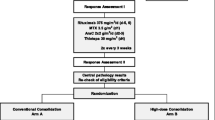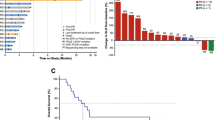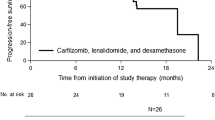Abstract
Single agent studies targeting the tumor microenvironment in central nervous system (CNS) tumors have largely been disappointing. Combination therapies targeting various pathways and cell types may be a more effective strategy. In this phase I study, we evaluated the combination of dasatinib, lenalidomide, and temozolomide in children with relapsed or refractory primary CNS tumors. Patients 1–21 years old with relapsed or refractory CNS tumors were eligible. Starting doses of dasatinib and lenalidomide were 65 mg/m2/dose twice daily and 55 mg/m2 once daily, respectively, while temozolomide was constant at 75 mg/m2 daily. The study followed a 3 + 3 phase I design, with a 4-week dose-limiting toxicity (DLT) evaluation period. Serial peripheral blood lymphocyte subsets were evaluated in consenting patients. Fifteen patients were enrolled and thirteen were DLT-evaluable. DLTs occurred in 5 patients, including somnolence and confusion (1 patient), hypokalemia (1 patient) and thrombocytopenia (3 patients). The maximum tolerated dose for the combination was dasatinib 65 mg/m2 twice daily, lenalidomide 40 mg/m2 daily, and temozolomide 75 mg/m2 daily, for 21 days followed by 7 days rest in repeating 28-day cycles. Transient increases in natural killer effector cells and cytotoxic T-cells were seen after 1 week of treatment. One out of six response-evaluable patients showed a partial response. The combination was feasible and relatively well tolerated in this heavily pre-treated population. The most common toxicities were hematologic. Preliminary evidence of clinical benefit was seen.

Similar content being viewed by others
References
Ostrom QT, Gittleman H, Xu J, Kromer C, Wolinsky Y, Kruchko C, Barnholtz-Sloan JS (2016) CBTRUS statistical report: primary brain and other central nervous system tumors diagnosed in the United States in 2009–2013. Neuro Oncol 18:v1-v75. https://doi.org/10.1093/neuonc/now207
Glod J, Rahme GJ, Kaur H, E HR, Hwang EI, Israel MA (2016) Pediatric brain tumors: current knowledge and therapeutic opportunities. J Pediatr Hematol Oncol 38:249–260. https://doi.org/10.1097/MPH.0000000000000551
Blansfield JA, Caragacianu D, Alexander HR 3rd, Tangrea MA, Morita SY, Lorang D, Schafer P, Muller G, Stirling D, Royal RE, Libutti SK (2008) Combining agents that target the tumor microenvironment improves the efficacy of anticancer therapy. Clin Cancer Res 14:270–280. https://doi.org/10.1158/1078-0432.CCR-07-1562
Fang H, Declerck YA (2013) Targeting the tumor microenvironment: from understanding pathways to effective clinical trials. Cancer Res 73:4965–4977. https://doi.org/10.1158/0008-5472.CAN-13-0661
Dredge K, Marriott JB, Macdonald CD, Man HW, Chen R, Muller GW, Stirling D, Dalgleish AG (2002) Novel thalidomide analogues display anti-angiogenic activity independently of immunomodulatory effects. Br J Cancer 87:1166–1172. https://doi.org/10.1038/sj.bjc.6600607
Lu L, Payvandi F, Wu L, Zhang LH, Hariri RJ, Man HW, Chen RS, Muller GW, Hughes CC, Stirling DI, Schafer PH, Bartlett JB (2009) The anti-cancer drug lenalidomide inhibits angiogenesis and metastasis via multiple inhibitory effects on endothelial cell function in normoxic and hypoxic conditions. Microvasc Res 77:78–86. https://doi.org/10.1016/j.mvr.2008.08.003
Browder T, Butterfield CE, Kraling BM, Shi B, Marshall B, O’Reilly MS, Folkman J (2000) Antiangiogenic scheduling of chemotherapy improves efficacy against experimental drug-resistant cancer. Cancer Res 60:1878–1886
Hanahan D, Bergers G, Bergsland E (2000) Less is more, regularly: metronomic dosing of cytotoxic drugs can target tumor angiogenesis in mice. J Clin Invest 105:1045–1047. https://doi.org/10.1172/JCI9872
Sounni NE, Noel A (2013) Targeting the tumor microenvironment for cancer therapy. Clin Chem 59:85–93. https://doi.org/10.1373/clinchem.2012.185363
Friedman HS, Petros WP, Friedman AH, Schaaf LJ, Kerby T, Lawyer J, Parry M, Houghton PJ, Lovell S, Rasheed K, Cloughsey T, Stewart ES, Colvin OM, Provenzale JM, McLendon RE, Bigner DD, Cokgor I, Haglund M, Rich J, Ashley D, Malczyn J, Elfring GL, Miller LL (1999) Irinotecan therapy in adults with recurrent or progressive malignant glioma. J Clin Oncol 17:1516–1525. https://doi.org/10.1200/JCO.1999.17.5.1516
Mesti T, Moltara ME, Boc M, Rebersek M, Ocvirk J (2015) Bevacizumab and irinotecan in recurrent malignant glioma, a single institution experience. Radiol Oncol 49:80–85. https://doi.org/10.2478/raon-2014-0021
Zapletalova D, Andre N, Deak L, Kyr M, Bajciova V, Mudry P, Dubska L, Demlova R, Pavelka Z, Zitterbart K, Skotakova J, Husek K, Martincekova A, Mazanek P, Kepak T, Doubek M, Kutnikova L, Valik D, Sterba J (2012) Metronomic chemotherapy with the COMBAT regimen in advanced pediatric malignancies: a multicenter experience. Oncology 82:249–260. https://doi.org/10.1159/000336483
Peyrl A, Chocholous M, Kieran MW, Azizi AA, Prucker C, Czech T, Dieckmann K, Schmook MT, Haberler C, Leiss U, Slavc I (2012) Antiangiogenic metronomic therapy for children with recurrent embryonal brain tumors. Pediatr Blood Cancer 59:511–517. https://doi.org/10.1002/pbc.24006
Aplenc R, Blaney SM, Strauss LC, Balis FM, Shusterman S, Ingle AM, Agrawal S, Sun J, Wright JJ, Adamson PC (2011) Pediatric phase I trial and pharmacokinetic study of dasatinib: a report from the children’s oncology group phase I consortium. J Clin Oncol 29:839–844. https://doi.org/10.1200/JCO.2010.30.7231
Ahluwalia MS, de Groot J, Liu WM, Gladson CL (2010) Targeting SRC in glioblastoma tumors and brain metastases: rationale and preclinical studies. Cancer Lett 298:139–149. https://doi.org/10.1016/j.canlet.2010.08.014
Shi H, Zhang CJ, Chen GY, Yao SQ (2012) Cell-based proteome profiling of potential dasatinib targets by use of affinity-based probes. J Am Chem Soc 134:3001–3014. https://doi.org/10.1021/ja208518u
Fei F, Yu Y, Schmitt A, Rojewski MT, Chen B, Gotz M, Dohner H, Bunjes D, Schmitt M (2009) Dasatinib inhibits the proliferation and function of CD4+CD25+ regulatory T cells. Br J Haematol 144:195–205. https://doi.org/10.1111/j.1365-2141.2008.07433.x
Hekim C, Ilander M, Yan J, Michaud E, Smykla R, Vaha-Koskela M, Savola P, Tahtinen S, Saikko L, Hemminki A, Kovanen PE, Porkka K, Lee FY, Mustjoki S (2017) Dasatinib changes immune cell profiles concomitant with reduced tumor growth in several murine solid tumor models. Cancer Immunol Res 5:157–169. https://doi.org/10.1158/2326-6066.CIR-16-0061-T
Attal M, Lauwers-Cances V, Marit G, Caillot D, Moreau P, Facon T, Stoppa AM, Hulin C, Benboubker L, Garderet L, Decaux O, Leyvraz S, Vekemans MC, Voillat L, Michallet M, Pegourie B, Dumontet C, Roussel M, Leleu X, Mathiot C, Payen C, Avet-Loiseau H, Harousseau JL, Investigators IFM (2012) Lenalidomide maintenance after stem-cell transplantation for multiple myeloma. N Engl J Med 366:1782–1791. https://doi.org/10.1056/NEJMoa1114138
Berg SL, Cairo MS, Russell H, Ayello J, Ingle AM, Lau H, Chen N, Adamson PC, Blaney SM (2011) Safety, pharmacokinetics, and immunomodulatory effects of lenalidomide in children and adolescents with relapsed/refractory solid tumors or myelodysplastic syndrome: a Children’s Oncology Group Phase I Consortium report. J Clin Oncol 29:316–323. https://doi.org/10.1200/JCO.2010.30.8387
Giuliani M, Janji B, Berchem G (2017) Activation of NK cells and disruption of PD-L1/PD-1 axis: two different ways for lenalidomide to block myeloma progression. Oncotarget 8:24031–24044. https://doi.org/10.18632/oncotarget.15234
Newlands ES, Stevens MF, Wedge SR, Wheelhouse RT, Brock C (1997) Temozolomide: a review of its discovery, chemical properties, pre-clinical development and clinical trials. Cancer Treat Rev 23:35–61
Kim JT, Kim JS, Ko KW, Kong DS, Kang CM, Kim MH, Son MJ, Song HS, Shin HJ, Lee DS, Eoh W, Nam DH (2006) Metronomic treatment of temozolomide inhibits tumor cell growth through reduction of angiogenesis and augmentation of apoptosis in orthotopic models of gliomas. Oncol Rep 16:33–39
Wong ET, Timmons J, Callahan A, O’Loughlin L, Giarusso B, Alsop DC (2016) Phase I study of low-dose metronomic temozolomide for recurrent malignant gliomas. BMC Cancer 16:914. https://doi.org/10.1186/s12885-016-2945-2
Milano V, Piao Y, LaFortune T, de Groot J (2009) Dasatinib-induced autophagy is enhanced in combination with temozolomide in glioma. Mol Cancer Ther 8:394–406. https://doi.org/10.1158/1535-7163.MCT-08-0669
Jungkunz-Stier I, Zekl M, Stuhmer T, Einsele H, Seggewiss-Bernhardt R (2014) Modulation of natural killer cell effector functions through lenalidomide/dasatinib and their combined effects against multiple myeloma cells. Leuk Lymphoma 55:168–176. https://doi.org/10.3109/10428194.2013.794270
Facon T, Leleu X, Stewart AK, Spencer A, Rowlings P, Hulin C, Attal M, Garzon F, Bleickardt E, Gialelis K, Tuozzoli D, Derreumaux D, Sonneveld P (2009) Dasatinib in combination with lenalidomide and dexamethasone in patients with relapsed or refractory multiple myeloma: preliminary results of a phase I study. Blood 114:1876–1876
Cencini E, Fabbri A, Arrigucci U, Cerase A, Bocchia M (2017) Lenalidomide and temozolomide combination in a very elderly patient with CNS relapse of diffuse large B-cell lymphoma. Mediterr J Hematol Infect Dis 9:e2017040. https://doi.org/10.4084/MJHID.2017.040
Laack NN, Galanis E, Anderson SK, Leinweber C, Buckner JC, Giannini C, Geoffroy FJ, Johnson DR, Lesser GJ, Jaeckle KA, Sarkaria JN (2015) Randomized, placebo-controlled, phase II study of dasatinib with standard chemo-radiotherapy for newly diagnosed glioblastoma (GBM), NCCTG N0877 (Alliance). J Clin Oncol 33:2013–2013. https://doi.org/10.1200/jco.2015.33.15_suppl.2013
Le Tourneau C, Lee JJ, Siu LL (2009) Dose escalation methods in phase I cancer clinical trials. J Natl Cancer Inst 101:708–720. https://doi.org/10.1093/jnci/djp079
Trissel LABRF., Zhang YB, Koontz SEPB. (2006) Temozolomide stability in extemporaneously compounded oral suspensions. Int J Pharm Compd 10:396–399
Cohen KJ, Heideman RL, Zhou T, Holmes EJ, Lavey RS, Bouffet E, Pollack IF (2011) Temozolomide in the treatment of children with newly diagnosed diffuse intrinsic pontine gliomas: a report from the Children’s Oncology Group. Neuro Oncol 13:410–416. https://doi.org/10.1093/neuonc/noq205
Apperley JF, Cortes JE, Kim DW, Roy L, Roboz GJ, Rosti G, Bullorsky EO, Abruzzese E, Hochhaus A, Heim D, de Souza CA, Larson RA, Lipton JH, Khoury HJ, Kim HJ, Sillaber C, Hughes TP, Erben P, Van Tornout J, Stone RM (2009) Dasatinib in the treatment of chronic myeloid leukemia in accelerated phase after imatinib failure: the START a trial. J Clin Oncol 27:3472–3479. https://doi.org/10.1200/JCO.2007.14.3339
Neyns B, Tosoni A, Hwu WJ, Reardon DA (2010) Dose-dense temozolomide regimens: antitumor activity, toxicity, and immunomodulatory effects. Cancer 116:2868–2877. https://doi.org/10.1002/cncr.25035
Perry JR, Belanger K, Mason WP, Fulton D, Kavan P, Easaw J, Shields C, Kirby S, Macdonald DR, Eisenstat DD, Thiessen B, Forsyth P, Pouliot JF (2010) Phase II trial of continuous dose-intense temozolomide in recurrent malignant glioma: RESCUE study. J Clin Oncol 28:2051–2057. https://doi.org/10.1200/JCO.2009.26.5520
Omuro A, Chan TA, Abrey LE, Khasraw M, Reiner AS, Kaley TJ, Deangelis LM, Lassman AB, Nolan CP, Gavrilovic IT, Hormigo A, Salvant C, Heguy A, Kaufman A, Huse JT, Panageas KS, Hottinger AF, Mellinghoff I (2013) Phase II trial of continuous low-dose temozolomide for patients with recurrent malignant glioma. Neuro Oncol 15:242–250. https://doi.org/10.1093/neuonc/nos295
Fadul CE, Fisher JL, Gui J, Hampton TH, Cote AL, Ernstoff MS (2011) Immune modulation effects of concomitant temozolomide and radiation therapy on peripheral blood mononuclear cells in patients with glioblastoma multiforme. Neuro Oncol 13:393–400. https://doi.org/10.1093/neuonc/noq204
Sengupta S, Marrinan J, Frishman C, Sampath P (2012) Impact of temozolomide on immune response during malignant glioma chemotherapy. Clin Dev Immunol 2012:831090. https://doi.org/10.1155/2012/831090
Ridolfi L, Petrini M, Granato AM, Gentilcore G, Simeone E, Ascierto PA, Pancisi E, Ancarani V, Fiammenghi L, Guidoboni M, de Rosa F, Valmorri L, Scarpi E, Nicoletti SV, Baravelli S, Riccobon A, Ridolfi R (2013) Low-dose temozolomide before dendritic-cell vaccination reduces (specifically) CD4+CD25++Foxp3+ regulatory T-cells in advanced melanoma patients. J Transl Med 11:135. https://doi.org/10.1186/1479-5876-11-135
Funding
The project described was supported in part by Award Number P30CA014089 from the National Cancer Institute. The content is solely the responsibility of the authors and does not necessarily represent the official views of the National Cancer Institute or the National Institutes of Health.
Author information
Authors and Affiliations
Corresponding author
Ethics declarations
Conflict of interest
The authors declare that they have no conflict of interest.
Additional information
Nathan J. Robison and Kee Kiat Yeo have contributed equally to the manuscript.
Electronic supplementary material
Below is the link to the electronic supplementary material.
Rights and permissions
About this article
Cite this article
Robison, N.J., Yeo, K.K., Berliner, A.P. et al. Phase I trial of dasatinib, lenalidomide, and temozolomide in children with relapsed or refractory central nervous system tumors. J Neurooncol 138, 199–207 (2018). https://doi.org/10.1007/s11060-018-2791-y
Received:
Accepted:
Published:
Issue Date:
DOI: https://doi.org/10.1007/s11060-018-2791-y




